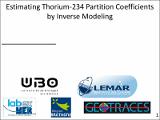Por favor, use este identificador para citar o enlazar a este item:
http://hdl.handle.net/10261/219687COMPARTIR / EXPORTAR:
 SHARE
BASE SHARE
BASE
|
|
| Visualizar otros formatos: MARC | Dublin Core | RDF | ORE | MODS | METS | DIDL | DATACITE | |

| Título: | Estimating Thorium-234 Partition Coefficients by Inverse Modeling |
Autor: | Le Gland, Guillaume CSIC ORCID; Aumont, Olivier; Mémery, Laurent | Fecha de publicación: | ago-2019 | Citación: | Goldschmidt (2019) | Resumen: | Thorium-234 (234Th), an insoluble radio-isotope scavanged by marine particles, can be used as a proxy of the biological carbon pump (BCP). Thorium-234 observations can constrain biogeochemicalmodels, but a necessary first step is to estimate the poorly known partition coefficients, representing the affinity of 234Thfor each particle type.In our study, weestimatedthe partition coefficientsfor five particle types,differing in size and chemical composition,byfittinga234Thmodel to a dataset, a process called “inverse modeling”.Our3D time-dependent model is based on the ocean general circulation model NEMO-OPA and the particle concentrations of a biogeochemistry modelcoupled with NEMO:PISCESv2. Our global dataset contains more than5000 234Thobservations, including GEOTRACES data.Surface partition coefficients are estimated between 0.79 and 16.7 x 106.Biogenicsilica has the smallest partition coefficients. Small particulate organic carbon and lithogenicdust have the largest. Thorium-234 observations at depth cannot be recovered without adding an extra degree of freedom, allowingthe modelpartition coefficients to increase by one order of magnitude from surface to 1000 m deep.Some horizontal biases inPISCESparticle distributionscan also be identified.In our time-dependent global 3D model, the biases introduced by three common assumptions made in BCP studies can be quantified. First, using the C:234Th ratio of large particles alone leads to an overestimation of carbon export at the base of the euphotic layer, by up to a factor 2, especially in subtropical gyres where large particles are scarce. Furthermore, assuming steady state and neglecting transport by advection and diffusion can bias fluxes by as much as 50%, especially at high latitudes and in upwellings, with a sign and intensity depending on the season | Descripción: | Goldschmidt2019, 18-23 August 2019, Barcelona.-- 26 pages, figures, tables | URI: | http://hdl.handle.net/10261/219687 |
| Aparece en las colecciones: | (ICM) Comunicaciones congresos |
Ficheros en este ítem:
| Fichero | Descripción | Tamaño | Formato | |
|---|---|---|---|---|
| Le_Gland_et_al_2018.pdf | 2,77 MB | Adobe PDF |  Visualizar/Abrir |
CORE Recommender
Page view(s)
89
checked on 24-abr-2024
Download(s)
149
checked on 24-abr-2024
Google ScholarTM
Check
NOTA: Los ítems de Digital.CSIC están protegidos por copyright, con todos los derechos reservados, a menos que se indique lo contrario.
